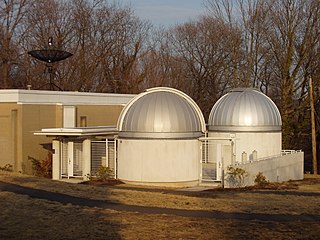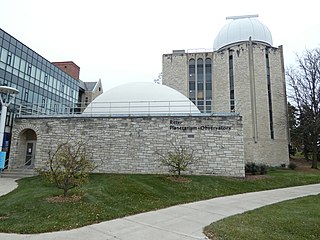
East Lansing is a city in the U.S. state of Michigan. Most of the city lies within Ingham County with a smaller portion extending north into Clinton County. The population was 48,579 at the 2010 census, an increase from 46,420 at the 2000 census. Located just east of the state capital of Lansing, East Lansing is well-known as the home of Michigan State University. The city is part of the Lansing–East Lansing metropolitan area.

The Adler Planetarium is a public museum dedicated to the study of astronomy and astrophysics. It was founded in 1930 by Chicago business leader Max Adler. It is located on the northeast tip of Northerly Island at the shore of Lake Michigan in Chicago, Illinois. The Adler was the first planetarium in the United States and is part of Chicago's Museum Campus, which includes the John G. Shedd Aquarium and The Field Museum. The Adler's mission is to inspire exploration and understanding of the universe.

The MDM Observatory is an optical astronomical observatory located adjacent to Kitt Peak National Observatory on Kitt Peak, west of Tucson, Arizona, in the United States. It is owned and operated by the University of Michigan, Dartmouth College, Ohio State University, Columbia University, and Ohio University. The Massachusetts Institute of Technology (MIT) was also part of the operating consortium in the past.

The 1.8 meter Alice P. Lennon Telescope and its Thomas J. Bannan Astrophysics Facility, known together as the Vatican Advanced Technology Telescope (VATT), is a Gregorian telescope observing in the optical and infrared situated on Mount Graham in southeast Arizona, United States. It achieved its first light in 1993.

Mount Laguna Observatory (MLO) is an astronomical observatory owned and operated by San Diego State University (SDSU). The telescope was operated in partnership with the University of Illinois at Urbana-Champaign (UIUC) until 2000. MLO is located approximately 75 kilometers (47 mi) east of downtown San Diego, California (USA) on the eastern edge of the Cleveland National Forest in the Laguna Mountains on the SDSU Astronomy Campus near the hamlet of Mount Laguna. MLO was dedicated on June 19, 1968, seven years after SDSU's Department of Astronomy became an independent academic department of SDSU's College of Sciences. The dedication took place during the 1968 summer meeting of the Astronomical Society of the Pacific. Currently SDSU is working with University of Kansas (KU), and UNC Chapel Hill on various projects.

Maynard F. Jordan Observatory is an astronomical observatory owned and operated by University of Maine. Its first telescope was installed at the university in 1901, and was upgraded during the creation of the Emera Astronomy Center in 2014. It is located in Orono, Maine, USA. It is the only public observatory in the state of Maine. Operated by the department of Physics and Astronomy, the eight-inch Alvan Clark telescope is housed under a roll-off roof, next to the more modern PlaneWave CDK20 in its own dome.

Brooks Observatory is an astronomical observatory owned and operated by the University of Toledo. The observatory is used primarily for public viewing and undergraduate instruction. It hosts an array of small telescopes, the centrepiece of which is a Celestron 14 Edge HD. It is located on the campus of the University of Toledo in Toledo, Ohio (USA), occupying the 6th floor of McMaster Hall, home to the Department of Physics and Astronomy.

The William G. and Retha Stone Baker Observatory is an astronomical observatory owned and operated by Missouri State University. It is located in Marshfield, Missouri.

Angell Hall Observatory is an astronomical observatory owned and operated by University of Michigan. It is located on the UM Central Campus on top of Angell Hall in Ann Arbor, Michigan (US). It has a computer-controlled 0.4-m Cassegrain telescope in its single dome, and a small radio telescope on the roof. In the past it has housed a large, clock-driven refracting telescope and a reflecting telescope in side-by-side domes. The current telescope was manufactured by DFM Engineering and installed in December 1994.

The Allan I. Carswell Astronomical Observatory, formerly known as the York University Astronomical Observatory, is an astronomical observatory owned and operated by York University. It is located in the North York district of Toronto, Ontario, Canada. Opened in 1969, York's observatory is opened to both researchers and amateur astronomers. The observatory was renamed the Allan Ian Carswell Astronomical Observatory in 2017 after York University Emeritus Professor of Physics Allan Carswell.

The Yale University Observatory, also known as the Leitner Family Observatory and Planetarium, is an astronomical observatory owned and operated by Yale University, and maintained for student use. It is located in Farnham Memorial Gardens near the corner of Edwards and Prospect Streets, New Haven, Connecticut.

Holcomb Observatory and Planetarium is a part of Butler University in Indianapolis, Indiana.

Fuertes Observatory is an astronomical observatory located on the North Campus of Cornell University in Ithaca, New York. The observatory was designed by L.P. Burnham, Cornell Professor of Architecture and completed in fall of 1917. It was originally used by the Civil Engineering Department as an instructional field office for navigation and surveying. Today, the observatory is primarily used for public outreach, welcoming over two thousand visitors per year with open houses on clear Friday nights.

The Orchard Hill Observatory is an astronomical observatory located at the highest point on the University of Massachusetts Amherst campus. Constructed in 1965, the observatory is a red brick building with a 16-inch Cassegrain reflector optical telescope. It is used for several community events and is regularly open for public viewing on Thursday nights. Originally the observatory was home to a 20” telescope, given to the department by an avid amateur who lived in central Massachusetts. It was a 1/10 scale model (loosely) of a larger 200” scope. Eventually, a crack was spotted during one of the re-aluminizings of the 20” mirror and the scope was no more. In the meantime, the department had been granted money associated with its move from Hasbrouck to the Grad Research Tower to buy a small telescope and put in on top of the GRC. The GRC had a small "isolation" pad built on its roof, which was supposed to be a mount for the scope, which could be accessed via a small open elevator. However, the GRC had terrible noise and gross vibration problems. The isolation pad never worked and there were too many safety concerns about using the roof of the building for observing. A 16" telescope was later bought from Competition Associates. That scope arrived in 1976 but because of the problems with using the top of the GRC, the scope was never mounted there. In fact, it sat in the basement of Hasbrouck for perhaps 10 years, becoming known as the "Subterranean Telescope.” This situation finally led to the 20" being disassembled and the 16" scope being moved to Orchard Hill and installed in the dome there. The 16" was a major improvement in usability. As to what happened to the 20", the mirror may have been stored in the Astronomy Research Facility but the drive was most likely not kept.
The Astronomical Society of South Australia (ASSA) was founded in 1892 and is the oldest society of its kind in Australia. It is the only representative body for amateur astronomy in the state of South Australia. It holds regular general monthly meetings, frequent meetings for members of specialised groups and has available two observatories, one with a 300mm telescope at The Heights School within easy reach of Adelaide and used primarily for public viewing, and a second at Stockport with 500mm and 450mm telescopes presently in service and a larger 36-inch instrument currently being considered.
Abrams Planetarium is the planetarium on the campus of Michigan State University, Michigan, United States.

The Dark Sky Observatory (DSO) is an astronomical observatory owned and operated by Appalachian State University (ASU). It is located 9 kilometers (5.6 mi) east of Deep Gap, North Carolina (USA), off of the Blue Ridge Parkway, and 32 kilometers (20 mi) east of the ASU campus in Boone, North Carolina It was established in 1981, and is used for research, instruction, and public viewing events. The Cline Visitors' Center was completed in 2011.

The Ritter Observatory is an astronomical observatory owned and operated by the University of Toledo (UT) in Toledo, Ohio (USA). The Ritter Planetarium is located in the same building, and the university also operates Brooks Observatory in an adjacent building. Ritter Observatory features a 1.06 m (42 in) Ritchey-Chrétien telescope built in 1967 by Warner & Swasey Company of Cleveland, Ohio. It was installed in 1968, and is used primarily for spectroscopy and occasionally for instruction and public viewing events. Research conducted at the observatory focuses on long-term spectroscopic monitoring of stars such as Rigel, Beta Lyrae, and Zeta Tauri.

The Peach Mountain Observatory (PMO) is an astronomical observatory owned and operated by the University of Michigan (UM). It is located near the village of Dexter, Michigan (USA), about 20 kilometers (12 mi) northwest of Ann Arbor. It was opened in 1955, and is used for research, instruction, and amateur observing.
















